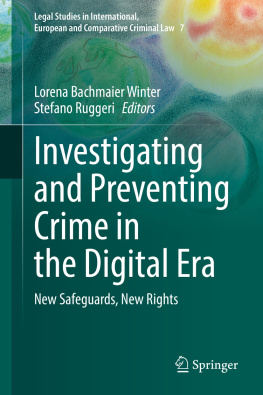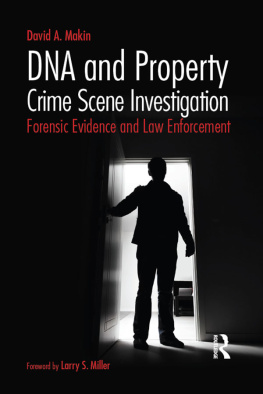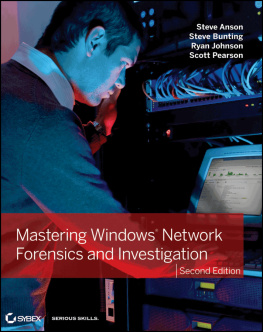First Published 2011 by Anderson Publishing
Published 2015 by Routledge
2 Park Square, Milton Park, Abingdon, Oxon OX14 4RN
and by Routledge
711 Third Avenue, New York, NY 10017, USA
Routledge is an imprint of the Taylor & Francis Group, an informa business
2011, Taylor & Francis. All rights reserved.
No part of this book may be reprinted or reproduced or utilised in any form or by any electronic, mechanical, or other means, now known or hereafter invented, including photocopying and recording, or in any infor mation storage or retrieval system, without permission in writing from the publishers.
Notices
No responsibility is assumed by the publisher for any injury and/or damage to persons or property as a matter of products liability, negligence or otherwise, or from any use of operation of any methods, products, instructions or ideas contained in the material herein.
Practitioners and researchers must always rely on their own experience and knowledge in evaluating and using any information, methods, compounds, or experiments described herein. In using such information or methods they should be mindful of their own safety and the safety of others, including parties for whom they have a professional responsibility.
Product or corporate names may be trademarks or registered trademarks, and are used only for identification and explanation without intent to infringe.
This book and the individual contributions contained in it are protected under copyright by the Publisher (other than as may be noted herein).
Library of Congress Control Number: 2010935324
British Library Cataloguing-in-Publication Data
A catalogue record for this book is available from the British Library.
ISBN 978-1-4377-5582-4 (pbk)
Table of Contents
The topic of high-technology crime and cybercrime is discussed much more today than it was five years ago when the first edition of this text was released. Computers have become integral parts of the daily lives of citizens around the world. The number of individuals who gain access to the World Wide Web, both for legitimate and for illegitimate reasons, continues to increase every day. Criminal activities involving computers and technology continue to be a problem for the criminal justice system. It is worth noting that while crime numbers have increased over the last five years, the criminal justice response has also increased. Today there are more criminal justice agencies staffing cybercrime-related investigators. Additionally, there are more computer forensics services available for investigators. However, there is still a continuing need to increase awareness and understanding of cyber-related crime.
There is an incredible amount of literature on the topic of cybercrime, ranging from works on cybercrime in general to more specific works that focus on particular cyber-related crimes. However, the current work seeks to continue its original goalto provide an introductory level of coverage to a rapidly changing field of the criminal justice system. This work is written for those who have limited or no knowledge of how computers work and/or computer networking principles. Readers are introduced to various complex topics in an easy-to-understand format. It is the hope of the author that these materials can be of use not just to university students but also to those who are currently working in the criminal justice field.
The book is divided into three sections. The first section consists of an introduction to high-technology crime, which is also commonly referred to as cybercrime . The second section addresses investigative issues associated with the investigation and prosecution of these crimes. The final section provides readers with some insight into the future of study in the area of high-technology crime, including current issues and an introduction to the emerging field of cybercriminology.
It is not the intent of this work to make the reader an expert in the area of high-technology crime, for no single work could accomplish this. The field is complex and constantly changing, as the technology used by both the criminals and the criminal justice system continues to evolve. Instead, the reader should view this work as a starting point for future study and research on the topic. To assist in this process each chapter concludes with a series of review questions designed to highlight the important terminology and concepts presented within each chapter. Each chapter also contains reference to related books, articles, or court cases that have been selected to provide interested readers with a means of continuing their education in this area. There are also a variety of websites and organizations that maintain a virtual presence on the World Wide Web, many of which provide up-to-date information on many of the topics discussed in this work. Therefore, each chapter will contain a brief listing of relevant websites that readers may visit in order to continue learning about the topics addressed in each chapter. Finally, every chapter except the final one will contain a brief spotlight on a news story that addresses how the materials discussed in the chapter are used or encountered in practice. These news stories are relatively recent; the stories come from news sources within the previous two to three years, with the majority published in the year before press time. The final chapter covers the new and exciting area of cybercriminology. Scholars in this area of study are working to gain a better understanding of what causes individuals to engage in the many cyber-related crimes that are discussed in this work. While there are few news articles that address these studies, numerous academic journal articles and textbooks are being developed on the topics, and readers are provided with information on these works.
As with the first edition, it is the hope of this author that this work will motivate readers to become more involved in the areas of research and training in the high-technology crime field.
Chapter 1
An Introduction to High-Technology Crime
When discussing crimes that involve computers and technology it is possible that prior to this reading the term high-technology crime may not have been heard by the reader. The term technology is often used to refer to mechanical or electrical devices that assist individuals in their day-to-day activities, but what does it mean to discuss high technology ? As this is a work designed for those who are either interested in or currently involved in the field of criminal justice, let us take the standard equipment of a law enforcement officer as an example. Today, most all law enforcement personnel carry a firearm of some type, regardless of whether they elect to utilize a revolver or a semi-automatic. Is the officers firearm a piece of technology? Of course. The firearm is a highly mechanical device, with the revolver having been developed by Samuel Colt in 1836. Therefore, the firearm is a piece of technology and one that has been around for more than a 100 years. Now, is the firearm a piece of high technology? This could be debatable, as some would consider the complex designs and manufacturing components of the firearm to make it a highly sophisticated piece of technology. But does being highly sophisticated equate to being considered high technology? Probably not. In the eyes of this author, the term high technology invokes images of highly developed electronic devicesmore in line with the components that make up a cellular telephone than the components of a firearm.
It is worth noting that for many people what they consider to be a computerthe large electronic device that we type our research papers on and use to browse the Internetis not the limitation for the technology. A computer is an electronic device that allows the user to input information, process that information, and then receive results that are based on the information provided by the user. Many of these devices do not come with monitors or keyboards. For example, many of us now commonly use a debit card at the local convenience store, thereby saving us the time and effort it takes to write out a check. To complete our financial transactions, the cashier merely takes our debit card and swipes the magnetic strip through a small machine, returning our card to us when he or she is finished. The small device attached to the cashiers cash register will obtain our account number from the magnetic strip on the back of the debit card. We as users then enter our PIN onto the keypad, and the transaction is either approved or rejected. The machine that reads our debit cards is a miniature computer. Furthermore, the debit card scanner would meet our earlier established criteria for being considered an example of a high-technology device. Another example of technological devices seeing increased use in our society would be cellular telephones. In the five years since the first edition of this text was published, a number of cellular phone manufacturers continue to release phones containing increasingly advanced software applications. Todays cellular phone can allow users from around the world to input information, process information, and send or receive information almost instantaneously. Each of these devices is a highly sophisticated electronic device that would therefore meet the previously discussed definition of a high-technology device. Now that we have a basic understanding of some examples of high-technology devices, questions that remain involve gaining a better understanding of high-technology crime and determining whether such criminal behavior is a serious problem that truly warrants examination and consideration.












